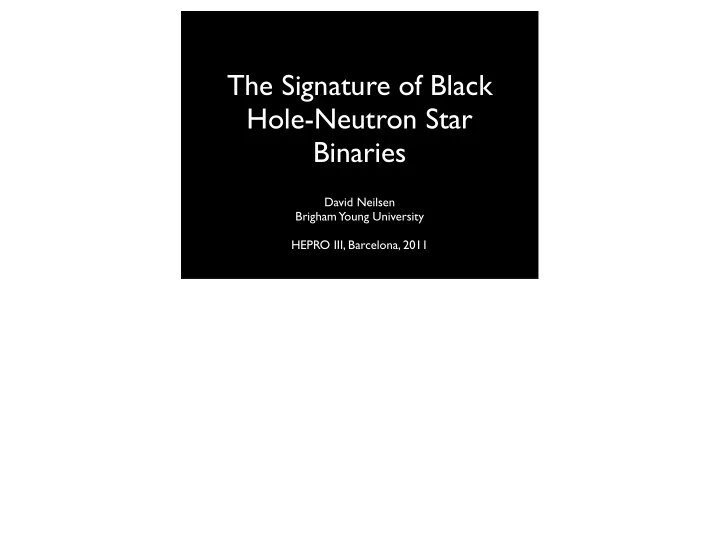

The Signature of Black Hole-Neutron Star Binaries David Neilsen Brigham Young University HEPRO III, Barcelona, 2011
Collaborators • Matthew Anderson (Louisiana State University) • Eric Hirschmann (Brigham Young University) • Luis Lehner (Perimeter Institute/U Guelph) • Steve Liebling (Long Island University) • Patrick Motl (Indiana University Kokomo) • Carlos Palenzuela (CITA)
BH-NS Mergers • Inspiral phase • Energy scale: 10 53 ergs • Time scale (primordial): 10 8 years • Merger phase • Disruption (inside or outside the ISCO) • Time scale 10-20 ms • Accretion phase • Tidal tails & disk • Time scale 10-100+ s
Two Roads • Newtonian or PPN Gravity + Nuclear Physics + Neutrinos • Rosswog+ (2002, 2005, 2007, 2010), WH Lee+ (2010) • General relativity + Ideal fluids • Faber+(2007), Etienne+(2009), Kyutoku+(2010), Duez+(2008), Chawla+ (2010), Stephens+ (2011)
BH-NS Parameter Space Star disrupts inside ISCO M BH /M NS Star disrupts outside ISCO BH Spin Figure after Duez 2011
This slide shows some features of our code. Don’t want to HAD concentrate on that. Draw attention to small portion of grid shown here. • Full Einstein equations Different length scales: (1) stars (2) orbit (3) wave zone • MHD with ideal fluid Use AMR, but still limited in resolution of EOS stars, compared to SNe. • Berger-Oliger AMR (refine both space & time) • Truncation error based refinement using shadow hierarchy • Distributed with MPI
Black Hole-Neutron (Chawla et al., PRL 2010) • Black hole • Mass M BH = 7 M ⊙ • Spinning and non-spinning a = 0 , a = 0 . 5 • Neutron Star • Mass M = 1 . 4 M ⊙ • Polytrope R = 15 km • Magnetic field Γ = 2 • System • q=5 and initial separtion 100 km
BH-NS Snapshots t=5.9ms t=8.9ms t=13.3ms t=16.3ms t=20.0ms t=27.3ms
a=0.5 and B=10 12 G
Magnetic Field in Disk
Gravitational Waves a=0, B=10 12 a=0.5, B=0 & B=10 12
Accretion Disk • BH final spin Text a ≈ 0 . 56 • Disk mass M disk ≈ 1% M NS Solid-integrated mass Dash-bound matter Plus-mass outside ISCO Dot-Dash-4*unbound matter
Disk Temperature B=0 Initial B=10 12
Accretion Power Law d M d t ∝ t − 5 / 3
Binaries in Globular Clusters • Event rates of BH-NS binaries by tidal capture comparable to primordial binaries(Belczynski et al. 2010) • ~25% of SGRBs have offsets from host galaxies (Berger 2010) • Eccentric orbits vs. circular • Accretion rate for BH-NS on parabolic orbits depends on impact parameter (Stephens+ 2011; W.H. Lee+ 2010) • Accretion rate goes as t -5/3
Accretion Rate (GR) 100 1 0.01 formula1 0.0001 formula2 1e-06 6.81 6.95 1e-08 7.22 7.5 1e-10 1e+06 t (s) 0.0001 0.01 1 100 10000 Stephens, East, Pretorius (2011)
Accretion Rate (Newtonian) 53 DNS 2 x 1.4 DNS 2 x 1.1 52 DNS 1.1 & 1.6 DNS 2 x 1.2 51 DNS 2 x 1.3 DNS 2 x 1.5 log 10 (L acc [erg/s]) 50 DNS 2 x 1.6 NSBH 1.4 & 4 49 NSBH 1.4 & 6 NSBH 1.4 & 14 48 NSBH 1.4 & 16 47 NSBH 1.4 & 18 46 5/3 45 � ! t 44 43 42 -3 -2 -1 0 1 2 3 4 5 6 7 log 10 (t [s]) 1 min 1 hour 1 day Rosswog (2007); see also WH Lee+ (2010)
Caveat Emptor • Vacuum regions • “Atmospheric” fluid • Angular momentum • Cartesian codes in 3D • Disk mass & orbit sensitive to nonconservation • Magnetic fields in MHD • Initially confined to star • Treatment in vacuum regions is problematic (see Lehner’s talk)
Summary • Binary mergers candidates for SGRBs • Disk and accretion rates • Disk masses 0.01 M o (GR) to 0.1 M o (N) • Fallback accretion rate t -5/3 (GR), t -4/3 (N) • Primordial binaries vs. tidal capture • Closing the loop on input physics • GR + nuclear EOS + neutrinos • Magnetic fields (FFE + MHD)
Recommend
More recommend